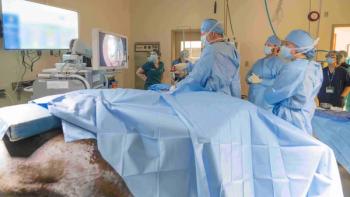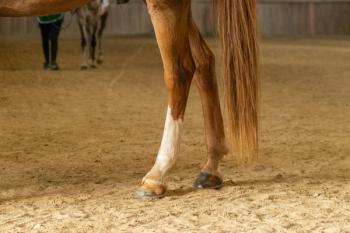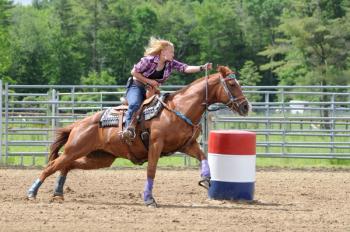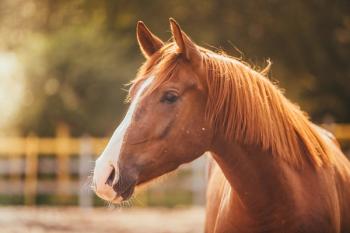
Elimination of abnormal respiratory noise in horses (Proceedings)
Sources of respiratory noise: laryngeal hemiplegia, dorsal displacement of the soft palate, pharyngeal collapse, alar fold flutter, epiglottic entrapment, axial deviation of aryepiglottic folds, lower airway inflammatory disease.
Sources of respiratory noise
• Laryngeal hemiplegia
• Dorsal displacement of the soft palate
• Pharyngeal collapse
• Alar fold flutter
• Epiglottic entrapment
• Axial deviation of aryepiglottic folds
• Lower airway inflammatory disease?
Sources of noise associated with inhalation
• Laryngeal hemiplegia
• Axial deviation of aryepiglottic folds
• Pharyngeal collapse
• Lower-airway inflammatory disease
• Epiglottic retroversion
• Alar fold flutter/collapse
Sources of noise associated with exhalation
• Dorsal displacement of the soft palate
• Alar fold flutter/collapse
• Epiglottic entrapment
• Lower-airway inflammatory disease?
Diagnosis of respiratory noise
• Can be a challenge!
• Not all pathologies have consistent noise production
o DDSP did not always produce an abnormal respiratory noise experimentally (Derksen et al AJVR 200l;(62) 659-664)
• Not all noises indicate pathology
• Resting endoscopy
• Treadmill endoscopy
• Sound analysis
o Treadmill
o Field
Sound analysis
• Acquisition of respiratory sounds
• Can be performed in the field or on treadmill with specialized microphone apparatus and recording device
• Recordings digitized and analyzed using computer-based spectrum analysis
• What sound recordings have been studied?
o Normal horse
o LLH-affected horse
o Dorsal displacement of soft palate
o Other pathologies?
o Alar fold flutter/collapse
• Both inhalatory and exhalatory with sharp spikes Cable et al AJVR 2002;(63)1707-13
o No other pathologies extensively studied
• Not easily reproduced experimentally
• Clinical prospectives necessary
Treatment for abnormal respiratory noise
• Identify source 1st!
• Source will dictate treatment
• Axial deviation of the aryepiglottic folds
o 52 racehorses with ADAF
• 83% had noise
• Laser resection had a more significant affect on noise reduction and return to racing
• Rest and anti-inflammatory therapy less effective
• Alar fold flutter/collapse
o Sound analysis moderate sensitivity and specificity in experimental alar fold collapse (Cable CS et al 2002 Dec;63(12):1707-13)
o In 22 race horses
• Manual elevation decreased noise in 11/11
• Clips or mattress sutures decrease noise in 8/8
• Surgical resection improved noise and performance in 71% (Hawkins JF et al JAVMA 1995 Jun 15;206(12):1913-6)
o FLAIR® nasal strips – will they be effective?
• Stabilize and tents external nares
• Decreases work of breathing (Holcombe SJ et al AJVR 2002 Aug;63(8):1101-5)
o Dorsal displacement of the soft palate
• Intermittent and often multifactoral etiology
• Don't always make a noise
• Difficult to diagnose
• Sternothyroideus tenectomy plus laser cautery of soft palate – 92% improved performance (Hogan et al AAEP Proc 2002;48:228-30) and 63% (Smith JJ, Vet Surg 2005;34:5-10)
• Tie-forward – 80% horses had improved performance (Woodie JB et al EVJ 2005;37:418-23)
• Anti-inflammatory therapy (steroids and throat spray)
o Other pathologies
• Lower airway inflammatory disease
• How much noise does mucus make?
• Steroid therapy (prednisolone or dexamethasone – decreasing doses)
o Often will have more than one problem!
Laryngeal hemiplegia and vocal fold collapse
• Most consistent source of abnormal respiratory noise is associated with laryngeal hemiplegia and vocal fold collapse
• Most widely studied
• Easily reproduced experimentally
• Experimental studies
o Bilateral ventriculocordectomy
o Prosthetic laryngoplasty
o Unilateral laser-assisted vocal cordectomy
o Unilateral laser-assisted ventriculocordectomy
• Experimental protocol
o Horses exercised on a treadmill at HRmax
o Respiratory sounds recorded and trans-upper airway pressures measured:
o Baseline
o 14 days after induction of LH by left recurrent laryngeal neurectomy
o 30, 60, 90 and 120 days following surgery
• Materials and Methods
o 6 standardbred horses
o Normal upper airway at rest and on treadmill exercising at HRmax
• Sound recordings
o Dynamic unidirectional microphone with cardioid pick-up pattern
o Respiratory sounds recorded on a audiocassette which were subsequently digitized for analysis
• Sound analysis
o Two different indices of sound measured with computer based spectrogram programa
o Sound level of inspiratory noise (dB)
o Sound intensity of characteristic formants (dB)
o Definitions
• Sound level
• 10 log (I/Is)
• Relative loudness of a sound
• Formant
• A region of concentration of sound energy prominent on a sound spectrogram that collectively constitute the frequency spectrum of a sound
• Trans-upper airway pressure
• Tracheal catheter with side holes
• Pressure transducer
• Difference between barometric and tracheal pressure
Bilateral ventriculocordectomy
• Often used in combination with laryngoplasty in LH-affected horses
• Removes the saccule and portion of vocal fold
• Stabilization of arytenoid via scar formation
• Surgical procedure
o General anesthesia via laryngotomy
o Saccule everted and excised with aid of sacculectomy burr
o 4 mm of vocal fold removed
o Axial free edge of vocal fold and abaxial free edge of saccule apposed
• Effect on respiratory noise
o Peak sound intensities of F2 and F3 to baseline values by 90 days following surgery
o Sound level improved, but not to baseline
• Effect on airway obstruction
o Inspiratory trans-upper airway pressures significantly improved from LH-values but remained different from baseline.
o 60-70% improvement in airway function
• Conclusions
o Bilateral ventriculocordectomy returns indices of sound to baseline
o Restores 60-70% of airway function
o Takes 90 days to be fully effective
Laryngoplasty
• First described by Marks
o Fixes arytenoid in abducted position
o "Gold Standard" for treatment of horses with laryngeal hemiplegia and exercise intolerance
• Procedure proven to return upper-airway mechanics to baseline (Derksen et al , AJVR 1986;47:16-20, Shappell et al, AJVR 1988;49:1760-65, Tetens et al, AJVR;57:1668-73)
• Proven an effective treatment for returning horses to racing (Hawkins et al, Vet Surg 1997;26:484-91, Russell et al, JAVMA 1994;8:1235-41, Spiers et al, Aust Vet J 1983;60:294-99, Strand et al, JAVMA 2000;217:1689-96)
• Improvement in respiratory sound production used as marker of success based on subjective measures (Marks et al, JAVMA 1970;157:157-63, Baker, Comp Cont Edu 1983;5:S61-S67, Spiers et al, Aust Vet J 1983;60:294-99, Hawkins et al, Vet Surg, 1997;26:484-91, Russell et al, JAVMA 1994;8:1235-41.)
• Degree of arytenoid abduction necessary for surgical success is debated
o Grading scale of arytenoid abduction following surgery was introduced by Russell et al JAVMA 1994; 204:1235-41
• Grade 5
• Arytenoid maximally abducted
• Caused depression in pharyngeal wall
• Grade 4
• Full abduction
• Contacting pharyngeal wall
• Grade 3
• Abduction just beyond intermediate position
• Not contacting pharyngeal wall
• Grade 2
• Arytenoid at intermediate position
• Grade 1
• Cartilage crossed midline of rima glottidis
• Effect on respiratory noise
o Laryngoplasty improved respiratory noise, but at no point did it return Formants or Sound Level to baseline values
o Improvement seen at 30 days post-operatively
o Degree of abduction positively correlated with noise production
• "Less is more" in regards to noise reduction in LH-affected horses
• Effect on airway obstruction
o Inspiratory trans-upper airway pressures returned to base-line at 30 days post-operatively
o Degree of abduction not correlated with upper airway pressure
• Conclusions
o Cannot predict the degree of remaining airway obstruction from noise in individual animals
o Therefore cannot predict surgical success based on residual sound following surgery
o The degree of arytenoid abduction did not correlate with Pui
o Eliminating LH-associated airway obstruction does not require maximal arytenoid abduction
Laser-assisted vocal cordectomy
• Used in conjunction with laryngoplasty
• Saccule remains
• Removal of vocal fold to increase the ventral diameter of the rima glottidis
• Performed in the standing sedated horse
o Decreases general anesthesia time
o No second incision
• Surgical Procedure
o As described by Ducharme et al (Ducharme NG et al Clin Tech in Eq Prac 2002;1:17-21)
• Effect on respiratory noise
o Formant 2 the only index of sound to improve from LH values, but remained significantly different from baseline
o Sound level, F1, and F3 remained significantly different from baseline and were not significantly improved from LH values at any time point
• Effect on airway obstruction
o Improved inspiratory pressures by 30 days post-operatively
o 40-50% improvement in obstruction
• Conclusions
o Not as effective as bilateral ventriculocordectomy or laryngoplasty in improving respiratory noise
o Improved airway obstruction, but to lesser degree than bilateral ventriculocordectomy
Laser-assisted ventriculocordectomy
• Used in conjunction with laryngoplasty
• Performed in the standing sedated horse
• No second incision compared to ventriculocordectomy performed through a laryngotomy
• Surgical procedure
o Sullins et al (AAEP Proceedings 2005 pg 312-16)
o Performed in standing sedated horse
o 980nm diode laser
o Trans-nasal sacculectomy burr to evert saccule
o Vocal fold & saccule excised
• Effect on respiratory noise
o Significantly improved all sound indices from LH values
o Sound level and formant 3 returned to baseline by 60 days after surgery (Robinson P, et al AAEP Proc 2005; 51:317-18)
• Effect on upper-airway pressures
o By 60 days after surgery inspiratory trans upper-airway pressures returned to baseline (Robinson P, et al AAEP Proc 2005; 51:317-18)
• Conclusions
o Removal of ventricle is necessary to eliminate noise
o As effective as BVC in noise improvement
o LAVC is as effective as laryngoplasty in alleviating airway obstruction
Clinical evaluations
• Laryngoplasty
o Often combined with vocal fold and ventricle surgery so difficult to make fair clinical assessments
o Studies utilize subjective data to evaluate noise and often increased performance
o Laryngoplasty plus ventricle/vocal fold surgery
• 106 Draft horses 72% reduction in noise (Kraus BM Vet Surg 2003532: 530-38)
• 48% noise reduction in 40 race horses
• The higher the degree of abduction, the more noise made. (Russell et al AP JAVMA 1994;204:1235-4)
• 75% had noise reduction in 168 racehorses, (80% had ventriculectomy) (Hawkins et al Vet Surg 1997;26:484-491)
• 73% noise elimination in mixed population of 200 horses (Dixon et al EVJ 2003;35:397-401)
• Laser-assisted ventriculocordectomy
o 23 horses with laryngeal hemiplegia treated with LAVC alone
o All had abnormal respiratory noise
o 48% had concurrent exercise intolerance
o 86% had complete resolution of abnormal noise
o 80% had resolution of exercise intolerance
Based on experimental and clinical evalutions which procedure is best?
• Which surgical procedure reduces sound more?
o Bilateral ventriculocordectomy and laser assisted ventriculocordectomy reduces some indices of sound to baseline levels
o With laryngoplasty sound indices improve but do not return to baseline
o Laser vocal cordectomy ineffective
• How long before improvement in sound noted?
o LAVC 60 days
o BVC 90 days
o Laryngoplasty 30 days
• How long before improvement in exercise intolerance?
o BVC - 90 days
o LAVC – 60 days
o Laryngoplasty – 30 days
• Which procedure is most effective in improving exercise intolerance?
o Laryngoplasty and LAVC equally effective in alleviating airway obstruction
• Will this hold true in the racehorse?
• Will this hold true over time?
Newsletter
From exam room tips to practice management insights, get trusted veterinary news delivered straight to your inbox—subscribe to dvm360.




